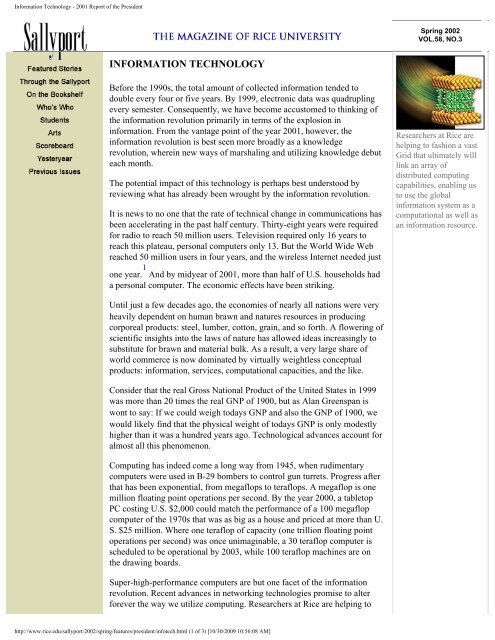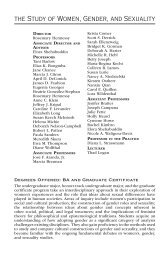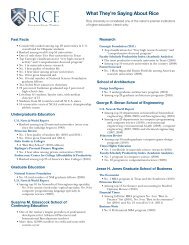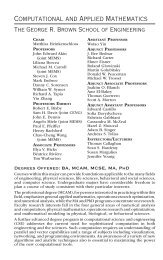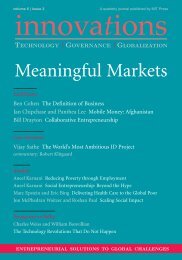Sallyport - The Magazine of Rice University - Spring 2002
Sallyport - The Magazine of Rice University - Spring 2002
Sallyport - The Magazine of Rice University - Spring 2002
You also want an ePaper? Increase the reach of your titles
YUMPU automatically turns print PDFs into web optimized ePapers that Google loves.
Information Technology - 2001 Report <strong>of</strong> the President<br />
<strong>Spring</strong> <strong>2002</strong><br />
VOL.58, NO.3<br />
INFORMATION TECHNOLOGY<br />
Before the 1990s, the total amount <strong>of</strong> collected information tended to<br />
double every four or five years. By 1999, electronic data was quadrupling<br />
every semester. Consequently, we have become accustomed to thinking <strong>of</strong><br />
the information revolution primarily in terms <strong>of</strong> the explosion in<br />
information. From the vantage point <strong>of</strong> the year 2001, however, the<br />
information revolution is best seen more broadly as a knowledge<br />
revolution, wherein new ways <strong>of</strong> marshaling and utilizing knowledge debut<br />
each month.<br />
<strong>The</strong> potential impact <strong>of</strong> this technology is perhaps best understood by<br />
reviewing what has already been wrought by the information revolution.<br />
It is news to no one that the rate <strong>of</strong> technical change in communications has<br />
been accelerating in the past half century. Thirty-eight years were required<br />
for radio to reach 50 million users. Television required only 16 years to<br />
reach this plateau, personal computers only 13. But the World Wide Web<br />
reached 50 million users in four years, and the wireless Internet needed just<br />
Researchers at <strong>Rice</strong> are<br />
helping to fashion a vast<br />
Grid that ultimately will<br />
link an array <strong>of</strong><br />
distributed computing<br />
capabilities, enabling us<br />
to use the global<br />
information system as a<br />
computational as well as<br />
an information resource.<br />
one year. 1 And by midyear <strong>of</strong> 2001, more than half <strong>of</strong> U.S. households had<br />
a personal computer. <strong>The</strong> economic effects have been striking.<br />
Until just a few decades ago, the economies <strong>of</strong> nearly all nations were very<br />
heavily dependent on human brawn and nature s resources in producing<br />
corporeal products: steel, lumber, cotton, grain, and so forth. A flowering <strong>of</strong><br />
scientific insights into the laws <strong>of</strong> nature has allowed ideas increasingly to<br />
substitute for brawn and material bulk. As a result, a very large share <strong>of</strong><br />
world commerce is now dominated by virtually weightless conceptual<br />
products: information, services, computational capacities, and the like.<br />
Consider that the real Gross National Product <strong>of</strong> the United States in 1999<br />
was more than 20 times the real GNP <strong>of</strong> 1900, but as Alan Greenspan is<br />
wont to say: If we could weigh today s GNP and also the GNP <strong>of</strong> 1900, we<br />
would likely find that the physical weight <strong>of</strong> today s GNP is only modestly<br />
higher than it was a hundred years ago. Technological advances account for<br />
almost all this phenomenon.<br />
Computing has indeed come a long way from 1945, when rudimentary<br />
computers were used in B-29 bombers to control gun turrets. Progress after<br />
that has been exponential, from megaflops to teraflops. A megaflop is one<br />
million floating point operations per second. By the year 2000, a tabletop<br />
PC costing U.S. $2,000 could match the performance <strong>of</strong> a 100 megaflop<br />
computer <strong>of</strong> the 1970s that was as big as a house and priced at more than U.<br />
S. $25 million. Where one teraflop <strong>of</strong> capacity (one trillion floating point<br />
operations per second) was once unimaginable, a 30 teraflop computer is<br />
scheduled to be operational by 2003, while 100 teraflop machines are on<br />
the drawing boards.<br />
Super-high-performance computers are but one facet <strong>of</strong> the information<br />
revolution. Recent advances in networking technologies promise to alter<br />
forever the way we utilize computing. Researchers at <strong>Rice</strong> are helping to<br />
http://www.rice.edu/sallyport/<strong>2002</strong>/spring/features/president/infotech.html (1 <strong>of</strong> 3) [10/30/2009 10:56:08 AM]


